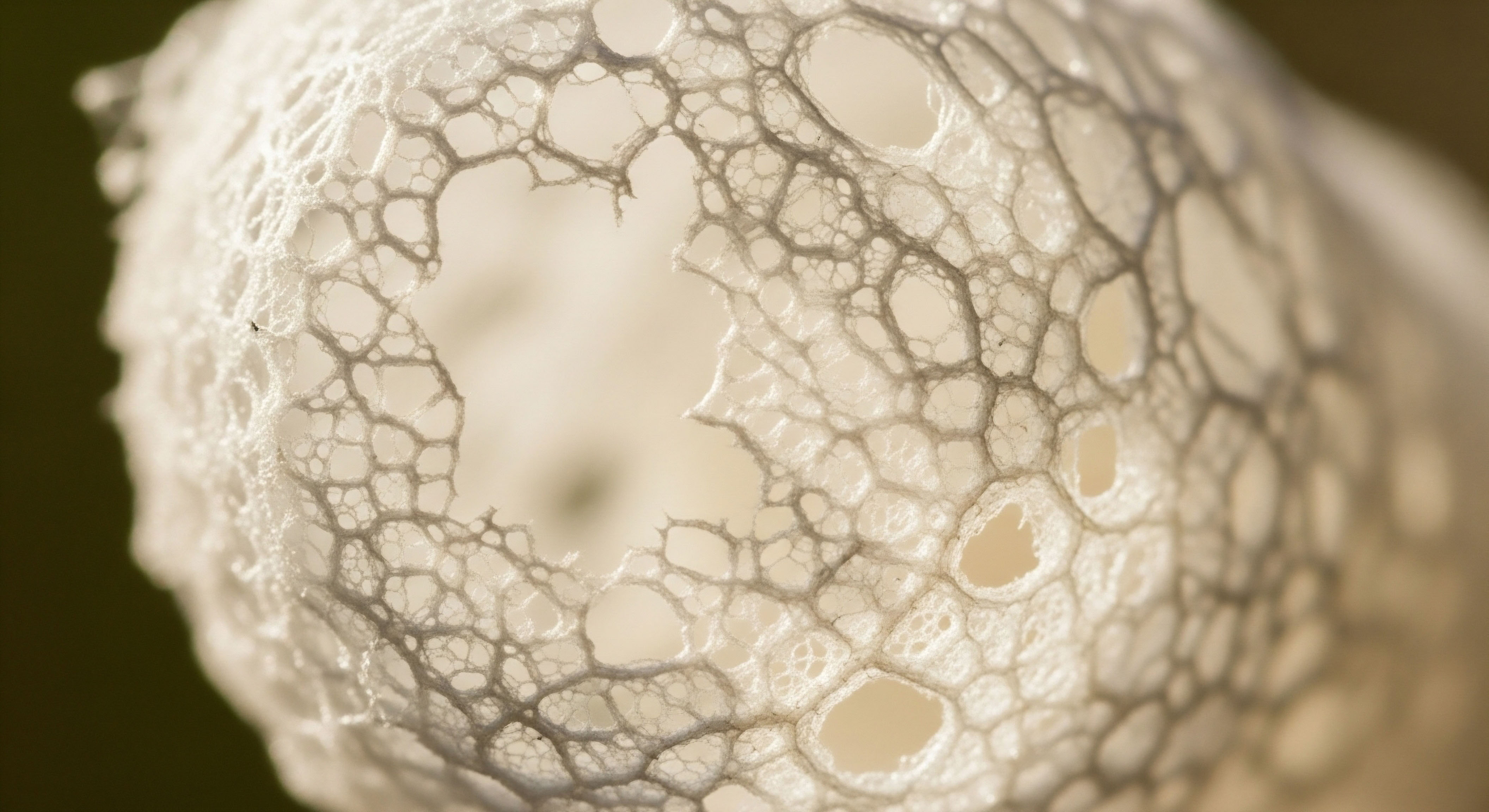

Fundamentals
You may have noticed a shift within your body. Perhaps it manifests as a pervasive fatigue that sleep does not resolve, a subtle change in your mood, or a general sense that your vitality has diminished. You might track your blood pressure, seeing the numbers as a clinical data point, a target to manage.
Your lived experience of these symptoms and the objective measurement of blood pressure are two dialects of the same language, telling the story of your body’s internal ecosystem. Understanding how hormonal protocols influence blood pressure begins with appreciating this connection. Your blood pressure reading is a direct report from the front lines of your cardiovascular system, reflecting a dynamic conversation between your hormones, your nervous system, and your kidneys.
This internal dialogue is what maintains equilibrium, a state of functional wellness. When we feel our best, this communication is seamless. When we feel unwell, it is often because a key voice in this conversation has been diminished or has become too loud.
Hormones are the primary messengers in this system, carrying critical instructions that dictate how your body manages its resources. They are the architects of your internal environment, and blood pressure is one of the most immediate and sensitive indicators of their work.

The Core Regulators of Vascular Tone
Your body possesses elegant, built-in systems designed to maintain blood pressure within a narrow, functional range. These systems operate continuously in the background, responding to every change in your activity, stress level, and hydration status. Gaining insight into these mechanisms is the first step toward understanding how personalized hormone therapies can interact with them.

The Renin-Angiotensin-Aldosterone System the Body’s Resource Manager
The Renin-Angiotensin-Aldosterone System (RAAS) is a foundational hormonal cascade that governs blood pressure. Think of it as your body’s internal resource and pressure management system. It begins in the kidneys, which are exquisite sensors of blood flow. When the kidneys detect a drop in pressure or a decrease in sodium levels, they release an enzyme called renin.
Renin initiates a chain reaction, converting a protein from the liver called angiotensinogen into angiotensin I. This compound then travels to the lungs, where an enzyme named Angiotensin-Converting Enzyme (ACE) transforms it into its highly active form, angiotensin II.
Angiotensin II is a powerful molecule with several critical functions. It is a potent vasoconstrictor, meaning it tightens blood vessels throughout the body, which immediately increases pressure within the vascular system. Simultaneously, it signals the adrenal glands, small endocrine organs sitting atop your kidneys, to release another hormone called aldosterone.
Aldosterone instructs the kidneys to retain sodium. As a governing principle of physiology, water follows sodium. This retention of sodium and water increases the total volume of blood in your circulation, which further elevates blood pressure over the medium and long term. This entire system is a beautiful example of a feedback loop designed to protect the body from dangerously low blood pressure.

Antidiuretic Hormone the Hydration and Volume Controller
Another key hormonal player is the Antidiuretic Hormone (ADH), also known as vasopressin. ADH is produced in the hypothalamus area of the brain and released from the posterior pituitary gland. Its release is triggered by two main signals ∞ an increase in the concentration of solutes in the blood (a sign of dehydration) or a direct drop in blood volume and pressure.
ADH acts on the kidneys, making them more permeable to water and causing them to reabsorb more water back into the bloodstream instead of excreting it as urine. This action concentrates the urine and conserves body water, effectively increasing blood volume and, consequently, supporting blood pressure. In situations of severe blood volume loss, such as a hemorrhage, ADH is released in very high quantities and also acts as a powerful vasoconstrictor.
Your blood pressure is a dynamic reflection of the hormonal messages regulating your body’s fluid volume and vascular tension.

Sex Hormones as Master Conductors
The RAAS and ADH systems provide the fundamental framework for blood pressure control. Sex hormones, such as estrogen and testosterone, act as master conductors, modulating the activity of these foundational systems. Their influence explains many of the observed differences in cardiovascular health between sexes and across different life stages.
Estrogen, for instance, generally has a protective influence on the cardiovascular system. One of its most important roles is to promote the production of nitric oxide, a molecule that relaxes the endothelial lining of blood vessels, a process called vasodilation. This widening of the blood vessels lowers peripheral resistance and helps maintain lower blood pressure. This mechanism is a primary reason why pre-menopausal women typically have a lower incidence of hypertension compared to men of a similar age.
Testosterone’s role is more complex. It is vital for maintaining muscle mass, bone density, and metabolic health. Within a healthy physiological range, it supports cardiovascular function. The way it influences blood pressure is multifaceted, involving direct actions on blood vessels and indirect actions through its conversion into other hormones, a topic we will explore in greater detail.
The journey to personalized wellness involves understanding how these powerful hormonal conductors are directing your body’s internal orchestra and how targeted protocols can help restore harmony to the performance.


Intermediate
Understanding the foundational systems of blood pressure regulation sets the stage for a more detailed examination of how specific hormone optimization protocols interact with this intricate machinery. When you embark on a journey of biochemical recalibration, whether for andropause, perimenopause, or proactive wellness, the therapeutic agents introduced become new voices in your body’s internal conversation.
The goal of these protocols is to restore clarity and balance to that dialogue. Each component, from testosterone to progesterone to peptide therapies, has a distinct effect on the vascular system and fluid dynamics.

How Does Male Hormone Optimization Affect Vascular Regulation?
For men experiencing the symptoms of low testosterone, a properly managed Testosterone Replacement Therapy (TRT) protocol can be transformative. The primary agent, Testosterone Cypionate, is designed to restore this critical hormone to an optimal physiological range. This restoration has direct consequences for blood pressure regulation.
Testosterone itself can promote vasodilation by enhancing the production of nitric oxide, similar to estrogen, which supports healthy blood flow and can help lower blood pressure. It improves endothelial function, the health of the inner lining of your blood vessels. However, the administration of exogenous testosterone also introduces other variables that require careful clinical management.
- Erythrocytosis A primary consideration in TRT is the potential for an increase in red blood cell mass, a condition known as erythrocytosis. This leads to a higher hematocrit level, which is the percentage of your blood composed of red blood cells. Elevated hematocrit increases the viscosity, or thickness, of the blood. Thicker blood requires more pressure to circulate, which can lead to an increase in blood pressure readings. This is one of the most common reasons for blood pressure elevation on TRT and is managed through dose adjustment, therapeutic phlebotomy, or both.
- Aromatization and Estrogen Management Testosterone can be converted into estradiol (a potent form of estrogen) by an enzyme called aromatase. This process, known as aromatization, is a natural part of male physiology. On TRT, however, this conversion can become excessive, leading to elevated estradiol levels. Estradiol can cause water retention, which increases blood volume and can subsequently raise blood pressure. To manage this, a medication like Anastrozole, an aromatase inhibitor, is often included in the protocol. It blocks the aromatase enzyme, reducing the conversion of testosterone to estradiol. The clinical art lies in finding the right balance. Suppressing estradiol too much can eliminate its beneficial vasodilatory effects, creating a different set of cardiovascular challenges.
- Supporting the HPG Axis Protocols often include agents like Gonadorelin or Enclomiphene. These substances work to maintain the function of the Hypothalamic-Pituitary-Gonadal (HPG) axis, the body’s natural hormone production command chain. By encouraging the body’s own systems to remain active, these agents can support a more balanced and stable internal hormonal environment, which contributes to more stable systemic functions, including blood pressure.

Female Hormone Protocols and Blood Pressure Dynamics
For women, hormonal shifts, particularly during perimenopause and post-menopause, dramatically alter cardiovascular risk. The decline in estrogen production is a central factor in this change. Hormone protocols for women are designed to mitigate these changes and restore a state of balance.
Optimizing hormone levels is a process of recalibrating the body’s key messengers to improve systemic function, including blood pressure control.
The loss of estrogen’s vasodilatory effects via nitric oxide pathways is a primary driver of the increase in blood pressure commonly seen in menopausal women. Restoring estrogen, even at physiological doses, can help preserve this crucial function. Progesterone is another vital component of female hormone balance.
Natural progesterone has a mild diuretic and natriuretic effect, meaning it helps the body excrete excess sodium and water. This action directly opposes the fluid-retaining effects of aldosterone and can be very beneficial for blood pressure management. The use of low-dose Testosterone Cypionate in women is aimed at improving energy, libido, and metabolic function.
When dosed appropriately for the female body, it does not typically carry the same risks of erythrocytosis or significant blood pressure increases seen in men.
The table below outlines the primary influences of key hormones used in optimization protocols on the mechanisms of blood pressure regulation.
| Hormone | Primary Positive Influence on BP Regulation | Primary Potential Negative Influence on BP Regulation |
|---|---|---|
| Testosterone | Promotes nitric oxide production and vasodilation; improves endothelial function. | Can increase hematocrit (blood viscosity); can convert to excess estradiol, causing water retention. |
| Estradiol | Strongly promotes nitric oxide-mediated vasodilation, lowering vascular resistance. | In excess, can cause significant sodium and water retention, increasing blood volume. |
| Progesterone | Acts as a natural diuretic, promoting sodium and water excretion; competes with aldosterone. | Effects are generally favorable; issues arise primarily with synthetic progestins, not bioidentical progesterone. |

Growth Hormone Peptides and Fluid Balance
Peptide therapies, such as those that stimulate the body’s own production of growth hormone (like Sermorelin or Ipamorelin/CJC-1295), are increasingly used for anti-aging, body composition, and recovery. These peptides work by signaling the pituitary gland to release growth hormone.
One of the known effects of increased growth hormone and its downstream mediator, IGF-1, is a tendency to cause some sodium and water retention, particularly in the initial phases of therapy. This can lead to a transient increase in blood pressure. For most healthy individuals, this effect is mild and resolves as the body adapts.
However, it is a critical parameter to monitor, especially for individuals with pre-existing hypertension. The long-term benefits of improved muscle mass, reduced visceral fat, and enhanced metabolic health can contribute to better overall cardiovascular function and blood pressure control over time.


Academic
A sophisticated analysis of how hormonal protocols affect blood pressure regulation requires moving beyond systemic effects and into the molecular and cellular arenas. The interplay between sex hormones and the renin-angiotensin-aldosterone system (RAAS) is a central nexus where these influences are exerted.
The vascular endothelium, the single-cell layer lining all blood vessels, is not merely a passive barrier. It is a dynamic, hormonally responsive endocrine organ that produces a host of vasoactive substances, with nitric oxide (NO) being paramount. The receptors for androgens and estrogens are present on endothelial cells and vascular smooth muscle cells, allowing these hormones to directly orchestrate vascular tone.

What Is the Molecular Basis of Sex Hormone Action on the Vasculature?
The influence of sex hormones on blood vessels occurs through both slow, genomic pathways and rapid, non-genomic pathways. The genomic pathway involves hormones diffusing into a cell, binding to an intracellular receptor, and the complex then traveling to the nucleus to alter gene transcription. This process takes hours to days.
The rapid, non-genomic effects occur within seconds to minutes and involve hormones binding to membrane-associated receptors, triggering intracellular signaling cascades that modulate ion channel activity and enzymatic function.

Androgen Receptors and Vascular Function
Testosterone’s effects are mediated through the androgen receptor (AR). Activation of ARs in vascular tissue can lead to vasodilation, an effect attributed to the opening of calcium-activated potassium channels in vascular smooth muscle cells, which leads to hyperpolarization and relaxation. This is a key mechanism through which healthy testosterone levels support cardiovascular compliance.
However, the RAAS provides a counter-narrative. Some evidence suggests that androgens can upregulate the expression of key components of the RAAS, including angiotensinogen and angiotensin-converting enzyme (ACE). This upregulation could potentially increase the production of the potent vasoconstrictor angiotensin II, creating a pro-hypertensive state if not properly balanced by other vasodilatory signals. This dual signaling potential underscores the clinical complexity of TRT.

Estrogen Receptors and Nitric Oxide Synthesis
The vascular benefits of estrogen are primarily mediated by estrogen receptor alpha (ERα). When estradiol binds to ERα on endothelial cells, it initiates a signaling cascade that activates the enzyme endothelial nitric oxide synthase (eNOS). The process unfolds as follows:
- Binding ∞ Estradiol binds to ERα located near caveolae, small invaginations in the cell membrane.
- Activation ∞ This binding rapidly activates the PI3K/Akt signaling pathway.
- Phosphorylation ∞ The Akt kinase then phosphorylates eNOS at a specific site (serine 1177), which dramatically increases its enzymatic activity.
- NO Production ∞ The activated eNOS enzyme converts the amino acid L-arginine into nitric oxide (NO).
- Diffusion and Relaxation ∞ NO, being a small gas molecule, diffuses from the endothelium to the adjacent vascular smooth muscle cells, where it activates guanylate cyclase, leading to cGMP production and profound muscle relaxation, or vasodilation.
The decline of estradiol during menopause leads to a significant reduction in this ERα-eNOS signaling, contributing to endothelial dysfunction, increased vascular stiffness, and a rise in blood pressure.

The Direct Hormonal Regulation of RAAS Components
The interaction is deeper than just parallel signaling. Sex hormones directly influence the expression and activity of the RAAS itself, creating a highly integrated control system. This is where the balance between androgens, estrogens, and progestogens becomes critically important for blood pressure homeostasis.
The table below details these intricate interactions at the molecular level, showing how different hormones can either amplify or dampen the body’s primary blood pressure elevation system.
| RAAS Component | Effect of Androgens (e.g. Testosterone) | Effect of Estrogens (e.g. Estradiol) | Effect of Progestogens (e.g. Progesterone) |
|---|---|---|---|
| Angiotensinogen (Liver) | Upregulates expression, increasing the substrate for renin. | Can also upregulate expression, a factor in OCP-related hypertension. | Minimal direct effect. |
| Renin (Kidney) | May increase expression and release. | Generally downregulates or has a neutral effect on renin release. | Minimal direct effect. |
| Angiotensin-Converting Enzyme (ACE) | May upregulate activity, increasing Angiotensin II production. | Downregulates expression and activity, reducing Angiotensin II production. | Minimal direct effect. |
| Aldosterone (Adrenal Gland) | May potentiate Angiotensin II’s effect on aldosterone release. | Generally has a suppressive effect on aldosterone synthesis. | Acts as a competitive antagonist at the mineralocorticoid receptor, blocking aldosterone’s action. |

Progesterone as an Aldosterone Antagonist
The role of progesterone is particularly elegant. Its molecular structure is very similar to that of aldosterone. This similarity allows natural progesterone to bind to the mineralocorticoid receptor (MR) in the kidneys, the same receptor that aldosterone targets to promote sodium retention. By binding to the MR without activating it, progesterone acts as a competitive antagonist.
It effectively blocks aldosterone from exerting its effect, which leads to natriuresis (sodium excretion) and diuresis (water excretion). This mechanism is a powerful, built-in counterbalance to the RAAS and is a key reason why bioidentical progesterone, unlike many synthetic progestins, is beneficial for blood pressure regulation in women undergoing hormone therapy.

References
- Stachenfeld, N. S. (2014). Blood pressure and water regulation ∞ understanding sex hormone effects within and between men and women. The Journal of Physiology, 592(Pt 18), 3935 ∞ 3941.
- Armando Hasudungan. (2013). Part I – Regulation of Blood Pressure (Hormones). YouTube.
- Geeky Medics. (2020). Regulation of Blood Pressure.
- Lappin, S. L. & Goswami, T. (2023). Physiology, Arterial Pressure Regulation. In StatPearls. StatPearls Publishing.
- Nonstop Neuron. (2024). Hormonal Control of the Circulation ∞ Vasoactive Compounds. YouTube.

Reflection
You have now explored the intricate biological pathways that connect your hormonal state to the pressure within your vascular system. This knowledge provides a new lens through which to view your own health data. The numbers on a blood pressure cuff are transformed from abstract metrics into meaningful signals from your body’s core regulatory systems.
This understanding is the foundational step. It shifts the perspective from one of passive observation to one of active, informed participation in your own wellness. Your unique physiology, your personal history, and your future goals will all shape your path forward. The information presented here is a map of the territory; the next step is to chart your own course with a guide who can help you interpret the specific signals your body is sending.



